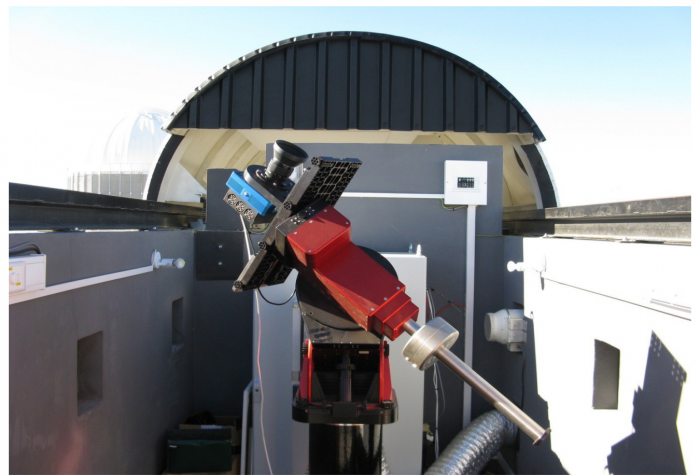- Title: The Kilodegree Extremely Little Telescope: Searching for
Transiting Exoplanets in the Northern and Southern Sky - Authors: Jack Soutter, Jonti Horner, Joshua Pepper, and the KELT Science Team.
- First author’s institution: University of Southern Queensland, Australia.
- Accepted to be published in the peer reviewed proceedings of the Australian Space Research Conference.
In the era of extremely large telescopes, let’s take look at the opposite end: the extremely little telescopes. KELT, or the Kilodegree Extremely Little Telescope, is one of them.

Figure 1: The KELT-South telescope at the South African Astronomical Observatory. Figure 1 from the paper.
KELT is a transiting exoplanet survey telescope. There are actually two KELTs: KELT-North at Winer Observatory in Arizona, and KELT-South at the South African Astronomical Observatory. Having telescopes in both hemispheres allows the KELT team to achieve complete coverage of the sky over the course of the year. Both telescopes are composed of a science-grade detector attached to a commercial camera lens with a 42mm aperture, on a computer controlled telescope mount, inside a smart weather-aware dome (see Figure 1).
KELT’s main science goal is to detect exoplanets using the transit method: KELT monitors stars for periodic brightness dips caused by orbiting planets passing in front of them. KELT has a large field of view, allowing for observations of a myriad of stars simultaneously. KELT focuses on breadth rather than depth, its search space being the nearest and brightest stars (specifically, KELT focuses on stars with 8 < V mag < 12).
A widely distributed approach to finding planets
Detecting planets around the nearest and brightest stars is especially interesting as these stars are easily accessible for follow-up verification using other telescopes. For this purpose, the KELT team has built a vast network of partners from other observatories all over the world (see Figure 2). Once the KELT science team has detected enough transits to accurately predict when the next transit of a given planet candidate will happen, they call up the KELT follow-up network to see if their prediction is correct, and to further characterize the planet’s orbit. If correct, KELT discovered a new planet.

Figure 2: KELT and the follow-up network: Locations of KELT-North, and KELT-South are shown in red. The location of follow-up observatories (blue pins) are distributed all over the world. Figure 2 from the paper.
Then, as the stars KELT focuses on are so bright, a plethora of other methods to characterize the planet are available. Larger, more precise telescopes, can be used to photometrically follow up future transits to precisely measure the radius of the planet. Precise spectroscopic follow-up can be used to measure the radial velocity (RV) variations of the host star, giving a measure of the planet’s mass. Combining radius and mass gives us the planet’s density, a handle on the planet’s bulk composition (is it a gas giant, or is it rocky?). Observing RV variations during a transit allows us to measure the Rossiter-McLaughlin effect (see astrobites on this effect here, here) to determine the orientation of the planet’s orbit with respect to the spin axis of its host star. And with detailed enough spectra during either primary (planet eclipses the star) or secondary transit (star eclipses the planet), we can measure the broad atmospheric composition of the planet.
A future of more planet discoveries
KELT has already detected a number of planets (see e.g. the discussion on KELT 1b, 2Ab, 3b, 4Ab, 6b, 7b, 8b, 10b, 14b, 15b in today’s paper), and the team has more discoveries on the way. Efforts such as KELT (check out also SuperWASP, HATNet, MINERVA, MEarth, and Evryscope) prove that exciting astronomy can be done by smaller-scale telescopes. In fact, small ground-based wide-field transit surveys are very important in the exoplanet detection hierarchy: they allow us to single out the interesting stars that have evidence of orbiting planets, allowing us to allocate observational resources much more efficiently.
Disclaimer: I know people in the KELT science team. I just find small telescopes, and their capability to do interesting science so fascinating. This astrobite is for all the small telescopes—the exoplanet scouts—out there.





Trackbacks/Pingbacks